2025.8.22
What Features Should You Look for in an ERP Solution?

Deciding on an ERP solution is a key step for any business, but with so many choices, it can be overwhelming. It’s important to know what you need, similar to buying a home.
In this blog, you can not only discover core ERP features, but also find an insightful checklist to guide you in making a confident and informed decision.
The Foundation: Understanding ERP’s True Value
Before diving into the specific features, let’s quickly explore why an ERP is vital. It’s more than just a piece of software; it’s a central nervous system for your business. It connects all your departments, from finance and HR to sales and inventory, into a unified system. A clear, real-time overview of your operations is essential for making informed, data-driven decisions.
The level of integration achieved here is compelling. A recent study by Panorama Consulting found that companies that invested in an ERP system reported an average 85% improvement in business processes.
So, while the selection process can be daunting, the payoff is well worth the effort. Now, let’s understand what to look for in an ERP system.
Top 4 Essential ERP Features to Put on Your List
A well-chosen ERP system should support daily operations, help your team work smarter, and enable better decision-making. That’s why it’s essential to go beyond surface-level features and carefully evaluate the core modules and functions to deliver the most value to your business.
Here are some of the most important modules and capabilities to consider:
- Financial Management
The core component of any ERP system is essential. Look for a module that can handle everything from general ledgers and accounts payable to budgeting and financial reporting. A sound finance module provides real-time data, so you can close your books faster and get a clear picture of your company’s health immediately.
- Supply Chain and Inventory Management
A game-changer for any business that deals with physical goods has arrived. An ERP system should give you a complete view of your inventory levels, orders, and shipments. Avoiding stockouts and overstocking is crucial, as both situations can lead to significant costs. According to a report by DocuClipper, 91% of organizations reported optimized inventory levels after ERP implementation. Look for automated alerts, demand forecasting, and vendor management features.
- Customer Relationship Management (CRM)
The best ERP systems seamlessly integrate CRM capabilities. Your sales and marketing teams can track leads, manage customer interactions, and analyze sales performance all in one location. It ensures the sales team has the most up-to-date inventory and order status information, leading to better customer service.
- Human Resources Management (HRM)
An HRM module can streamline many administrative tasks, from managing employee records and payroll to tracking performance and handling recruitment. Automating administrative tasks allows your HR team to concentrate on more strategic initiatives. Developing and enhancing company culture are crucial aspects to focus on. These are just a few of the many features of ERP software that can transform a business. The key is to find a system that offers the right combination of these modules to fit your specific needs.
Beyond the Modules: Your ERP Requirements Checklist
Your list shouldn’t just be about modules. A genuinely great ERP solution is defined by more than just its core functions. As you go through your ERP requirements checklist, consider these non-negotiable points:
- Scalability: Can the system grow with your business? If you plan to expand, open new locations, or increase your user base, your ERP needs to be able to handle it without a complete overhaul. Cloud-based ERP systems are particularly effective at flexible scaling, growing with your business without needing constant hardware upgrades. According to the ERP Statistics 2024 report by DocuClipper, cloud ERP solutions are projected to account for 60% of the total ERP market by 2025, up from just 40% in 2020.
- Integration Capabilities: Your new ERP system shouldn’t exist in a vacuum. It must connect with your existing software, like your website’s e-commerce platform or a specific logistics tool you use. Look for a system with robust APIs (Application Programming Interfaces) that make these connections smooth and straightforward.
- User Experience (UX): The level of integration achieved here is compelling. If a system is challenging to use, your employees will be slow to adopt it, and you won’t get the full value from your investment. Look for an intuitive, easy-to-navigate interface with customizable dashboards that give each user the information they need most.
- Vendor Support and Training: The relationship with your ERP provider doesn’t end after implementation. What kind of ongoing support do they offer? Do they provide comprehensive training for your team? A good vendor will be a true partner, helping you get the most out of your system. Research shows that organizations that engage ERP consultants report an 85% success rate in their implementations, so don’t underestimate the value of expert support.
Making the Right Choice
Making the final decision on an ERP system can be a significant risk, but focusing on these key criteria can significantly reduce that risk. A thorough understanding of your business needs and a precise ERP requirements checklist is the best way to ensure a successful implementation.
A long-term investment like this can fundamentally change how your business operates. Finding the right partner to guide you through this process is key. We at Avally are passionate about helping businesses like yours thrive. You can unlock incredible efficiency and growth with the right tools and support.